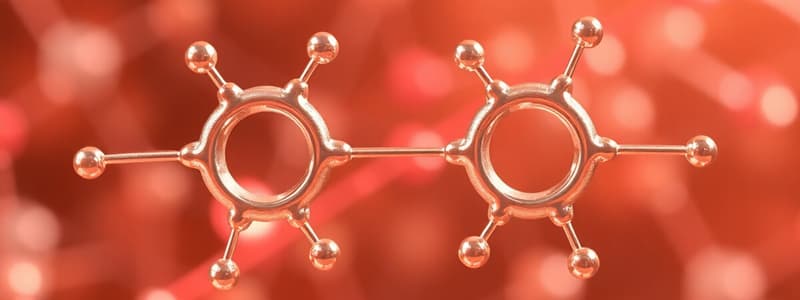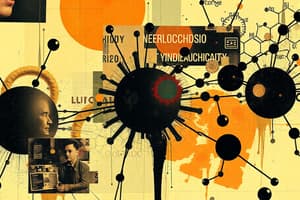Podcast
Questions and Answers
Which of the following molecules is nonpolar, despite having polar bonds?
Which of the following molecules is nonpolar, despite having polar bonds?
- Water (H2O)
- Ammonia (NH3)
- Carbon Dioxide (CO2) (correct)
- Sulfur Dioxide (SO2)
Which statement accurately describes the relationship between molecular polarity and intermolecular forces?
Which statement accurately describes the relationship between molecular polarity and intermolecular forces?
- Polar molecules typically have stronger intermolecular forces, such as dipole-dipole interactions and hydrogen bonding. (correct)
- Nonpolar molecules exhibit stronger dipole-dipole interactions compared to polar molecules.
- Polar molecules primarily exhibit London dispersion forces.
- Polar molecules tend to have weaker intermolecular forces due to their symmetrical shape.
Considering the principle of 'like dissolves like,' which solvent would be most suitable for dissolving a nonpolar substance like oil?
Considering the principle of 'like dissolves like,' which solvent would be most suitable for dissolving a nonpolar substance like oil?
- Ethanol
- Methanol
- Water
- Hexane (correct)
Which of the following factors is most important when determining whether a molecule is polar?
Which of the following factors is most important when determining whether a molecule is polar?
Based on VSEPR theory and polarity principles, which of the following molecules would be expected to have a net dipole moment?
Based on VSEPR theory and polarity principles, which of the following molecules would be expected to have a net dipole moment?
Which of the following best describes the relationship between electronegativity and bond polarity?
Which of the following best describes the relationship between electronegativity and bond polarity?
A molecule has polar bonds, but is determined to be nonpolar overall. Which of the following is the MOST likely explanation?
A molecule has polar bonds, but is determined to be nonpolar overall. Which of the following is the MOST likely explanation?
What is the primary factor that determines whether a molecule with polar bonds will be polar or nonpolar?
What is the primary factor that determines whether a molecule with polar bonds will be polar or nonpolar?
In which type of bond are electrons shared equally between two atoms?
In which type of bond are electrons shared equally between two atoms?
If two atoms have an electronegativity difference of 1.0, what type of bond is most likely to form between them?
If two atoms have an electronegativity difference of 1.0, what type of bond is most likely to form between them?
Which of the following factors determine the polarity of a molecule?
Which of the following factors determine the polarity of a molecule?
Which of the following molecules has a bent molecular geometry and is polar?
Which of the following molecules has a bent molecular geometry and is polar?
Flashcards
Polar Molecule
Polar Molecule
A molecule where the bond dipoles do not cancel, resulting in a net dipole moment.
Nonpolar Molecule
Nonpolar Molecule
A molecule where the bond dipoles cancel each other out, resulting in no net dipole moment.
"Like Dissolves Like"
"Like Dissolves Like"
Polar solvents dissolve polar solutes; nonpolar solvents dissolve nonpolar solutes.
Polarity vs. Boiling Point
Polarity vs. Boiling Point
Signup and view all the flashcards
Steps to Determine Polarity
Steps to Determine Polarity
Signup and view all the flashcards
Polarity (Chemistry)
Polarity (Chemistry)
Signup and view all the flashcards
Electronegativity
Electronegativity
Signup and view all the flashcards
Pauling Scale
Pauling Scale
Signup and view all the flashcards
Polar Bond
Polar Bond
Signup and view all the flashcards
Nonpolar Bond
Nonpolar Bond
Signup and view all the flashcards
Dipole Moment
Dipole Moment
Signup and view all the flashcards
Molecular Dipole Moment
Molecular Dipole Moment
Signup and view all the flashcards
Geometry & Polarity
Geometry & Polarity
Signup and view all the flashcards
Study Notes
- Polarity in chemistry refers to the distribution of electrical charge within a molecule or chemical bond.
- Molecules are either polar or nonpolar.
Electronegativity and Bond Polarity
- Electronegativity measures how strongly an atom attracts electrons in a chemical bond.
- The Pauling scale ranks electronegativity, generally ranging from 0.7 to 4.0.
- Fluorine is the most electronegative element.
- Bond polarity arises when two atoms with different electronegativities form a bond.
- The more electronegative atom attracts electron density, acquiring a partial negative charge (δ-).
- The less electronegative atom loses electron density, acquiring a partial positive charge (δ+).
- A polar bond is a covalent bond with unequal sharing of electrons.
- A nonpolar bond is a covalent bond with equal sharing of electrons.
- An electronegativity difference less than 0.4 means the bond is nonpolar covalent.
- An electronegativity difference between 0.4 and 1.7 means the bond is polar covalent.
- An electronegativity difference greater than 1.7 means the bond is ionic.
- These ranges are guidelines and polarity depends on the specific atoms and the overall molecular structure.
Dipole Moments
- A dipole moment is a quantitative measure of the polarity of a bond or molecule.
- It equals the product of the magnitude of the partial charges (δ+ and δ-) and the distance between them.
- Dipole moments are vector quantities, having both magnitude and direction.
- Dipole moments are typically measured in Debye units (D).
- For diatomic molecules, the molecular dipole moment is the same as the bond dipole moment.
- For polyatomic molecules, the molecular dipole moment is the vector sum of all the individual bond dipole moments.
- If bond dipoles cancel each other out due to symmetry, the molecule is nonpolar, even if it contains polar bonds.
Molecular Geometry and Polarity
- Molecular geometry significantly affects overall molecular polarity.
- A molecule containing polar bonds may be nonpolar if the geometry is symmetrical and the bond dipoles cancel.
- Common symmetrical geometries include linear (e.g., CO2), trigonal planar (e.g., BF3), and tetrahedral (e.g., CH4).
- Water (H2O) is bent and polar because the bond dipoles do not cancel.
- Ammonia (NH3) is trigonal pyramidal and polar.
- Determining molecular polarity requires considering both bond polarities and molecular geometry.
Determining Polarity
- Steps to predict whether a molecule is polar or nonpolar:
- Determine the electronegativity difference for each bond.
- Draw the Lewis structure and find the molecular geometry using VSEPR theory.
- Draw the bond dipoles as vectors, showing direction and magnitude.
- Determine if the bond dipoles cancel each other out.
- If the bond dipoles cancel, the molecule is nonpolar; if they do not, the molecule is polar.
Examples of Polar Molecules
- Water (H2O): Bent geometry with polar O-H bonds that do not cancel.
- Ammonia (NH3): Trigonal pyramidal geometry with polar N-H bonds that do not cancel.
- Hydrogen Fluoride (HF): Large electronegativity difference between H and F.
- Sulfur Dioxide (SO2): Bent geometry with polar S-O bonds that result in a net dipole moment.
Examples of Nonpolar Molecules
- Carbon Dioxide (CO2): Linear geometry with polar C=O bonds that cancel each other out.
- Methane (CH4): Tetrahedral geometry with C-H bonds that have negligible polarity, and the symmetrical arrangement cancels out any minor dipoles.
- Boron Trifluoride (BF3): Trigonal planar geometry with polar B-F bonds that cancel each other out.
- Diatomic molecules of the same element, such as H2, O2, and Cl2, are nonpolar.
Polarity and Solubility
- "Like dissolves like" is a guiding principle for solubility.
- Polar solvents dissolve polar solutes, and nonpolar solvents dissolve nonpolar solutes.
- Polar substances are generally soluble in polar solvents like water.
- Nonpolar substances are generally soluble in nonpolar solvents like hexane or toluene.
Polarity and Physical Properties
- Polar molecules tend to have higher melting points and boiling points compared to nonpolar molecules of similar molecular weight.
- Stronger intermolecular forces such as dipole-dipole interactions and hydrogen bonding exist between polar molecules.
- Nonpolar molecules primarily exhibit weaker London dispersion forces.
Studying That Suits You
Use AI to generate personalized quizzes and flashcards to suit your learning preferences.
Description
Understand polarity in chemistry, which describes the charge distribution in molecules and bonds. Learn about electronegativity, the Pauling scale, and how differences in electronegativity lead to polar and nonpolar bonds, affecting molecular properties.



